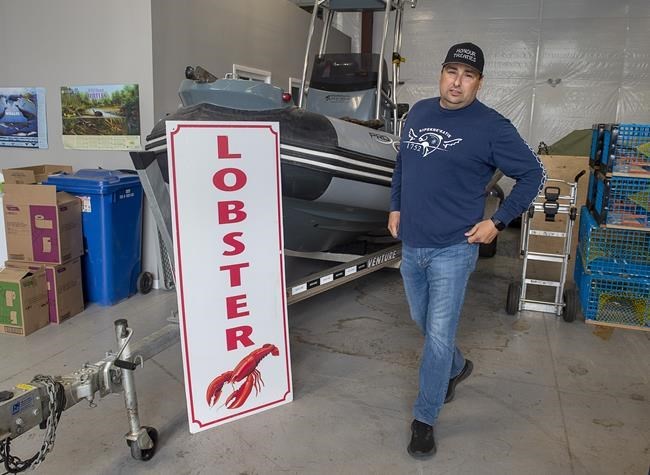INDIAN BROOK, N.S. — A Mi'kmaq community is scaling back plans for a lobster harvest in southwestern Nova Scotia next week after Ottawa threatened to pull traps that aren't licensed by the Fisheries Department.
Sipekne'katik Chief Mike Sack told reporters Thursday that instead of pursuing a "moderate livelihood" fishery with up to 50 traps per boat, Indigenous fishers will begin the season with a smaller food, social and ceremonial fishery.
In a phone interview later in the day, he said the ceremonial fishery in St. Marys Bay would involve about "four or five" lobster traps per person on the boat, adding that the fishery is expected to expand later in the year.
On April 22, the band announced that about 20 boats would fish out of Saulnierville, N.S., beginning in June, despite warnings from the federal government the traps would be seized.
Sack says the scaled-down fishery is authorized under food, social and ceremonial licences from the Fisheries Department, which permit a small catch, provided the harvest is for food and ceremonies.
The chief, however, also says that fishers will be permitted by the band to sell a portion of their catch to pay for expenses.
He also said the band plans to increase the catch later in the summer when more supporters are able to travel safely to the wharf in Saulnierville.
"We are holding off our bigger (moderate livelihood) treaty fishery until we have a bigger fleet there and we're allowed to have protection there," he said. "It's a scaled-back fishery because of the dangers that are out there."
The chief said that currently, the risks of COVID-19 mean a limited number of supporters are able to travel to Saulnierville from the First Nation north of Halifax.
Jane Deeks, an aide to federal Fisheries Minister Bernadette Jordan, said fishing under a food, social and ceremonial licence can be done outside federally regulated commercial seasons, but the catch cannot be sold. She said the department works closely with Indigenous communities "to ensure they are upholding the licence conditions, and we will continue to do so."
Earlier in the day, Jordan had said enforcement officers would be out "doing their job" if the First Nation proceeded with plans to return to St. Marys Bay next week to resume its "moderate livelihood" fishery without federal licences. That comment came a few hours before the department returned about 100 previously seized traps to the band.
The Mi'kmaq First Nation has argued it has the right to fish for a moderate livelihood when and where members wish, based on a landmark 1999 Supreme Court decision. The court later clarified that ruling to say Ottawa could regulate the treaty right for conservation and other limited purposes.
Jordan also said during a news conference in Lunenburg, N.S., that non-Indigenous fishers shouldn't consider "taking the law into their own hands" once Sipekne’katik First Nation resumes fishing off southwestern Nova Scotia.
After launching a self-governed fishery last fall, members of the band encountered violence from non-Indigenous residents, resulting in the destruction of a lobster pound and the burning of a band member's van in southwestern Nova Scotia.
Since then, Jordan has noted her department has been unsuccessful in efforts to negotiate the distribution of commercial licences for Sipekne'katik within federally regulated fishing seasons.
She confirmed Thursday that during talks, Ottawa had offered the band access to Lobster Fishing Area 35, south of St. Marys Bay, which is considered one of the best lobster grounds in the province, but the band rejected the offer.
Sack has said the area is difficult for his community's fleet of smaller boats to navigate.
One veteran lobster licence broker in the Lower Wedgeport, N.S., area, Troy Doucette, said in an interview Thursday that recent sales of commercial licences in that area have ranged from $2.2 million to $2.6 million each.
This report by The Canadian Press was first published May 27, 2021.
Michael Tutton, The Canadian Press



